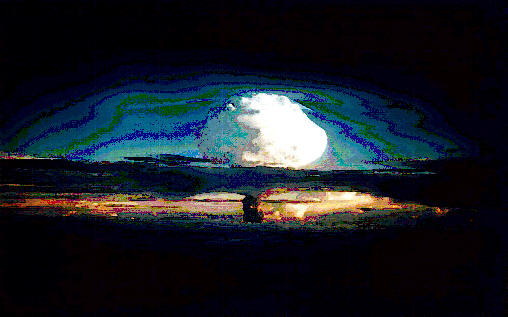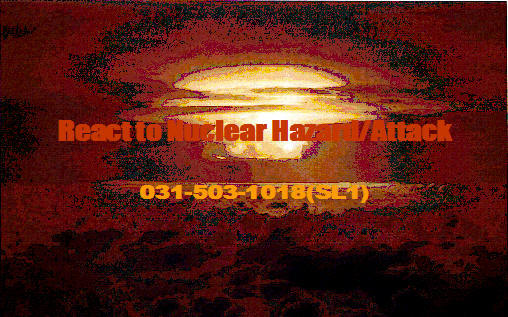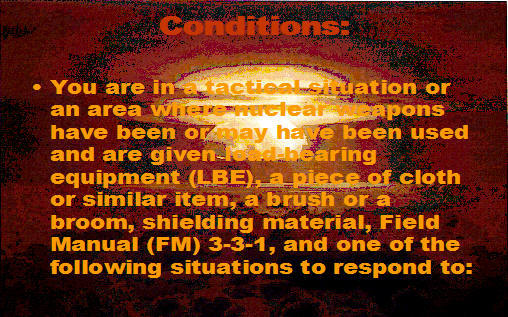React to Nuclear Hazard/Attack
Click here to download the presentation.



React to Nuclear Hazard/Attack
031-503-1018(SL1)
Conditions:
You are in a tactical situation or an area where nuclear weapons have been or may have been used and are given load-bearing equipment (LBE), a piece of cloth or similar item, a brush or a broom, shielding material, Field Manual (FM) 3-3-1, and one of the following situations to respond to:
SITUATIONS
You see a brilliant flash of light.
You find a standard radiological contamination marker or an enemy marker.
You are told that fallout is in the area.
You receive instructions to respond to a nuclear attack.
You come across a suspected depleted uranium (DU) hazard.
Standards:
React to a nuclear hazard or attack without becoming a casualty of a nuclear attack with or without warning. Identify radiological contamination markers with 100 percent accuracy, and notify the supervisor. Start the steps to decontaminate yourself within 1 minute of finding radiological contamination. Decontaminate your individual equipment after you completely decontaminate yourself.
PERFORMANCE STEPS
1. React to a nuclear attack without warning.
a. Close your eyes immediately.
b. Drop to the ground in a prone, head-on position.
Note. If you are in the hatch of an armored vehicle, immediately drop down inside the vehicle.
Performance Steps Cont.
c. Keep your head and face down and your helmet on.
d. Stay down until the blast wave passes and debris stops falling.
e. Cover your mouth with a cloth or similar item to protect against inhalation of dust particles.
f. Check for casualties and damaged equipment.
Performance Steps Cont.
2. React to a nuclear attack with warning.
a. Select and use the best available shelter (FM 3-3-1).
(1) Move into a fighting position, bunker, or ditch.
(2) Take protective actions if you are inside a shelter.
(3) Remain in place if you are in an armored vehicle.
Performance Steps Cont.
b. Protect your eyes.
c. Minimize exposed skin areas.
d. Cover your mouth with a cloth or similar item to protect against inhalation of dust particles.
Range to ground zero can be estimated by counting seconds from the very beginning of the flash to the arrival of the blast wave or sound of the explosion. Remember, the flash can temporally blind you, cover your eyes with your arm, you will still be able to see the flash through your skin! The possibility of terrorists using this type of attack makes knowing where it happened even more important.
React to a radiological contamination marker.
a. Avoid the area if possible.
Cross the area quickly by the shortest route that exposes you to the least amount of radiation based on mission, enemy, terrain, troops, time available, and civilian considerations (METT-TC).
Request crossing instructions if you must cross.
Make the maximum use of shielding.
Cover your mouth with a cloth or similar item to protect against inhalation of dust particles.
c. Report the discovery of a marker to your supervisor.
Remove radiological contamination (including DU) from clothing, equipment, and exposed skin.
Shake or brush contaminated dust (all dust is considered to be radioactive) from your clothing, equipment, and exposed skin with a brush, a broom, or your hands (if a brush or a broom is not available).
Wash your body as soon as possible, giving special attention to hairy areas and underneath your fingernails.
Conduct mission-oriented protective posture (MOPP) gear exchange if you are contaminated with wet radioactive contamination.
Radiation Effects
Total Exposure Visible Effect
0-50R No visible effects
50-200R Brief periods of nausea on day of exposure. 50% may experience radiation sickness (nausea and vomiting), 5% may require medical attention, no deaths are expected.
200-450R Most members of the group will require medical attention because of serious radiation sickness. 50% deaths within two to four weeks.
450-600R Serious radiation sickness in all members of the group, medical attention required. Death to more than 50% within one to three weeks.Over
600R Severe radiation sickness. 100% deaths in two weeks
References
FM 3-3-1FM 3-5